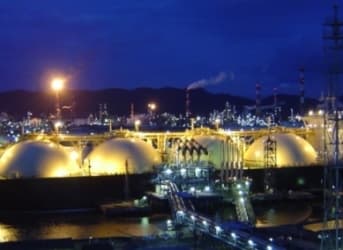The gravity of liquefied natural gas (LNG) demand shifted westwards over the past year.
For several years now, LNG demand – and as a result, the price of LNG – has been the highest in Asia. Japan is responsible for about one-third of total LNG imports worldwide, and China, although a smaller player, is projected to be one of the key drivers of growth for LNG imports. But the Fukushima meltdown forced Japan to scramble for imported energy to replace its shuttered nuclear reactors. It turned to much higher imports of oil, coal, and LNG to make up for the shortfall. Prices for LNG cargoes spiked.
This sparked a rush to build LNG export terminals in the west in order to take advantage of these high prices.
But now the opportunity is starting to shrink. Everyone has heard about the crash in oil prices, which is sinking LNG prices since they have traditionally been linked to the price of oil. The Japan Korea Marker (JKM) – the spot price in Asia – could be 38 percent lower in 2015 from a year earlier. Related: Is The EU Finally Breaking Free Of Russia’s Energy Grip?
However, it is more than just the collapse in crude oil prices. Another major factor is significantly lower import demand from China. China’s LNG import terminals are running well below their nameplate capacity. In 2014, Chinese import terminals only used 55 percent of their capacity, a decline from the 2013 utilization rate of 67.2 percent. To be clear, China brought several import terminals online over that timeframe, so the drop off in utilization is in part due to a larger denominator, not necessarily because of a smaller numerator.
In other words, it is not as if China’s LNG demand is in freefall. Still, China’s LNG consumption is growing much slower than anticipated. “The expansion of China’s gas supply infrastructure has outpaced the development of gas utilization,” Wang Zimeng, an analyst from Sublime China Information, told Interfax. In short, China is finishing off LNG import terminals but doesn’t need all the gas that those ports can handle.
Much of that has to do with the Chinese economy expanding at its slowest rate in 25 years last year. Slower growth trickles down to less demand for energy. But the fall in oil prices also allowed China to use more alternatives to imported gas. Even though spot LNG prices are falling as well, some of China’s imported gas is booked under long-term contracts, so cheaper oil undercuts demand for LNG.
Meanwhile, a dramatic development is underway in Europe, where LNG shippers are suddenly seeing surging demand for LNG. Europe is now actually surpassing Asia to become the strongest LNG market in the world.
LNG landings in Europe are now twice as high as they were last year, according to a Reuters report. Tankers are coming from all directions – from Qatar, Trinidad and Tobago, and Norway. They are destined to dock in Belgium, the UK, and the Netherlands. Related: Oil Prices May Recover, But Not LNG
The NBP marker – a price for LNG arriving in the United Kingdom – has actually surpassed the spot price in Asia, and has recently traded at $1.20-per-million-Btu premium. “Some trading companies are also trying to divert cargoes away from the east towards Europe,” an oil and gas trader told Reuters in an interview.
Considering the weak European economy, the swift rise in LNG imports has caught shippers off guard. But it shouldn’t be a surprise to those watching the European Union’s efforts to diversify its energy supplies. The motivating factor is to rid itself of Russian gas imports. And at the heart of the EU’s energy security strategy is natural gas – more gas pipelines, more processing and compressor stations, and more LNG import terminals. Whether or not making imported LNG a central pillar of its energy security strategy is a wise move, the EU is succeeding in finding gas supplies from outside of Russia. And shifting LNG prices are reflecting this move.
The largest growth potential for LNG over the long-term likely still resides in Asia. But for now, while it may be just temporary, Europe is the hottest market for LNG.
ADVERTISEMENT
By Nick Cunningham of Oilprice.com
More Top Reads From Oilprice.com:
- LNG Another Casualty Of Low Oil Prices
- US Sees Huge Energy Opportunity In Europe
- LNG Export Hopes Fading Fast For US



















I am at the Platt's LNG conference in Houston today and if there is one thing that all terminal operators agree on, it would be how much the regulatory process has slowed down their ambitions. It looks like in 2018-19 a lot of LNG will be coming online. If Nova Scotia has their way, they are only a 6 day trip from Europe. Great news for the EU.